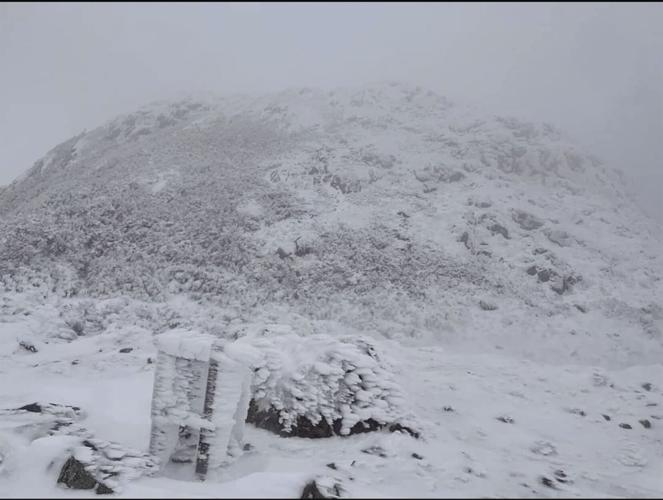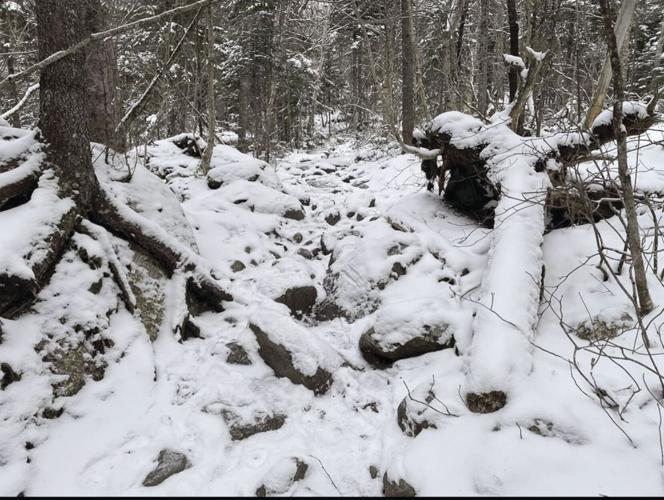FRANCONIA — Search and rescue teams recovered the body of 19-year-old Emily Sotelo, a college student from Massachusetts, last week on the north side of Mount Lafayette. Sotelo’s mother dropped her off at the trailhead on Sunday morning around 5 a.m. The goal: to solo hike three peaks including Lafayette, Mount Haystack and Mount Flume. There was snow on the ground and the high temperature for that day was just 24 degrees Fahrenheit. The low temperature was 9 degrees. Despite the conditions, Sotelo expected she would complete the 13.7-mile loop in a day.
When she failed to return to the trailhead on time Sunday evening, search and rescue teams started combing the mountain.
According to New Hampshire Fish and Game officers involved with the search, Sotelo was underdressed and had few or no supplies on her person, a pair of decisions that would ultimately prove fatal. Her body was recovered three days later on what would have been her 20th birthday.
Hiking fatalities are avoidable by following a few basic rules. Fall and winter hiking in the White Mountains is incredibly popular and enjoyable, but failure to take certain precautions can lead to disaster. By sticking to a few basic principles, hikers of all experience levels can enjoy New Hampshire's national forest safely in all seasons.
Sotelo reportedly had the ambitious goal of hiking all of New Hampshire's 48 4,000-footers by the age of 20. She had planned to hike from Sunday through her birthday on Wednesday, ending on Mount Isolation.
“It's great to have goals — we all want to push ourselves and say ‘I did that.’ But at what cost?” said Capt. Michael Eastman of New Hampshire Fish and Game. “Now we have a young lady who is deceased and had her whole life ahead of her.”
Eastman didn’t want to deter people from enjoying New Hampshire’s great outdoors, but said he'd rather see more people prepared.
“This isn't something where you drive into Eastern Mountain Sports, buy a backpack and jacket and do peaks in the wintertime and have success,” Eastman said of the White Mountains. “Some will do it and be successful, but it’s luck of the draw.”
Eastman shared some useful tips from his two decades of experiences as a conservation officer, as well as apps and other resources to stay safe on any hike.
The first rule to hiking safely is to be honest with yourself regarding your experience, fitness, knowledge and ability.
“It goes back to that old Clint Eastwood tenant, ‘Man's got to know his limitations,'" Eastman quoted. “If you're not prepared and in good condition to be hiking in ice, snow and winds and you’ve never done it before, you don't go out alone, and you stay below the treeline.”
Eastman added that those who've never done a winter or fall hike should never go alone. Factors or problems one could encounter along the trail will only be magnified in poor weather conditions, leading to a greater chance of injury or worse, so it's best to exercise caution and restraint when selecting routes for cold-weather hikes.
Once above the treeline on mountains like Lafayette, conditions can rapidly deteriorate. On the night of Sotelo’s ill-fated hike, temperatures on the mountain dropped to -30 due to windchill. Unfortunately, it appears that Sotelo pushed beyond the treeline in an attempt to reach the summit, before turning back downhill and winding up off trail.
“There is a 90-degree dogleg on that trail between the hut and the summit. This is a common area where people get waylaid,” Eastman said, adding that this was only a minor reason for Sotelo’s death. “That was the point when she went off the trail. At that point she started heading downhill and got into the drainage for Lafayette Brook. It was a very steep area. It took some of our searchers 20 minutes to get a quarter mile. And they were well equipped.”
Without proper equipment, it’s easy for hypothermia to set in. Once that happens, it’s easier to make even more mistakes.
“We're trying to make sense of something we would do when we're nice and warm, not hypothermic in a different frame of mind,” reflected Eastman of Sotelo’s situation. “Your hands and feet don't work the way you want to, you're panicking. She could have been in a bad spot before she hit that dogleg. The reason she got into the position she was in was because she was poorly provisioned, didn’t have lights, means to start a fire, means to get out of there.”
This is where tip two comes in. Plan ahead and prepare. Hikers should always check the weather forecast and adjust accordingly, as well as read up on areas they wish to travel. Eastman recommended checking in with the Mt. Washington Observatory web app and the National Weather Service for up-to-date conditions for the White Mountains.
“The one that I like right now is MyRadar,” Eastman said of a free phone application he uses. “It's specifically great to see where storms are coming in. It'll show you where you are based on your phone’s location. You can dial in where you are and it'll give you a five-day forecast, which is pretty accurate.”
Carrying food and water is essential to hiking safely. Staying hydrated and properly fed allows for clearer thinking and proper body temperature regulation.
“In cold temperatures you'll dehydrate faster than in the warmer temperatures,” Eastman pointed out. “Just really be ready for things to go wrong. Hope for the best, plan for the worst.”
Another important step to planning ahead is having an itinerary and sharing it with someone else. This was one step that Sotelo did take, and that led to her search and rescue effort. Had the weather been fairer, this may well have saved her life.
“The biggest take from Emily is that she had a plan that she stuck to,” Eastman said. “But she was unwilling to give up. She was driven to accomplish her itinerary. Just going on an aggressive hike that she went into, understanding that you gotta check the weather, it wasn't operable for what she had planned. Another day may have been a different outcome.”
Eastman stated that on the second day of the search, searchers encountered an incredibly lucky man who had summated the peak in a T-shirt and a small backpack.
“His face was frostbitten, I’m not sure how much it was worth it,” Eastman said. “There are people up there doing crazy things and getting away with it but it's not good to expect that to happen. I'm surprised we don't have more of it.”
To better one’s odds, Eastman and other sources recommend bringing multiple layers, a reliable way to make fire, and a pair of light sources.
“People need to understand, even if you're going out for a day hike, have some layers, have an extra outer shell, a hat, some gloves,” Eastman listed. “Have a bag with a lighter in it, and lights.”
Eastman also recommended having a backup flashlight or headlamp, as well as a few spare batteries. In cold temperatures, both regular batteries and cell phones can die much faster than normal. Hikesafe.com, a resource frequently referenced by NH Fish and Game, recommends bringing gear like a pocket knife, a compass, and a map of the area if possible. Another tip is to avoid wearing cotton layers. When cotton gets wet, it tends to stay that way and sap heat from the body. If possible, try to layer up using synthetics, wool and fleece.
When bringing a fire source, it’s always a good idea to have backup, and some starting material like dryer lint, a few pages of newspaper, or if you’re in a real pickle, dollar bills. It’s also essential to keep the fire kit in a waterproof container or bag. Even a few plastic grocery bags can do the trick.
According to Eastman, when Sotelo was found she didn’t appear to have a fire source or even a flashlight.
During the winter and fall, it’s especially important to be aware of body temperature.
“Even if you don't plan on being out sleeping, have a sleeping pad with you because it's something to sit on and retain heat,” Eastman explained, citing the barrier a pad creates between a hiker and the cold ground. “Those extra layers can help you retain some heat, the ability to get below treeline and make a fire. Sugary snacks are going to help maintain your body heat as well and up your metabolism.”
Now, let’s say you do plan ahead, you do bring proper equipment, but something happens and you need help. What do you do?
If you have a cell signal and a working phone, Eastman says to call 911. If not, it’s best to stay on the trail and start calling for help. From there, try to reach an area with reception to call emergency services.
“If you’re on a trail, you’re going to see some other hikers, but it might be some time,” Eastman said. “You’re going to have to push through.”
It may be tempting to go off trail toward a landmark or a perceived shortcut down to safety, but doing so makes it harder for rescuers to locate you. If you’re injured or immobilized, layer up, make a fire, stay on the trail and start calling for help.
While these precautions may lead to having a bigger and slightly heavier pack, it’s better to be safe than sorry.
“Check the weather, be flexible in your plan. If you don't get to the top today because it’s 50-mile-per-hour winds and 2 degrees, that's OK,” Eastman said. “Do something low. Do a smaller trail. A lower trail. Be flexible about it, be smart about it.”
For more information on hiking safety, visit hikesafe.com. Information on the White Mountains can be found at fs.usda.gov/whitemountain.
Fish and Game also offers a Hike Safe card for $25 a person, or $35 per family. Those who purchase the cards might not have to pay for search and rescue fees should they ever get in a jam. The money for the cards also goes directly to the Search and Rescue Fund. They can be purchased at wildlife.state.nh.us/safe.




















(0) comments
Welcome to the discussion.
Log In
Keep it Clean. Please avoid obscene, vulgar, lewd, racist or sexually-oriented language.
PLEASE TURN OFF YOUR CAPS LOCK.
Don't Threaten. Threats of harming another person will not be tolerated.
Be Truthful. Don't knowingly lie about anyone or anything.
Be Nice. No racism, sexism or any sort of -ism that is degrading to another person.
Be Proactive. Use the 'Report' link on each comment to let us know of abusive posts.
Share with Us. We'd love to hear eyewitness accounts, the history behind an article.